Chapter: Communication Theory : Noise Characterisation
Noise Characterisation
INTRODUCTION:
Noise is
often described as the limiting factor in communication systems: indeed if
there as no noise there would be virtually no problem in communications.
Noise is
a general term which is used to describe an unwanted signal which affects a
wanted signal. These unwanted signals arise from a variety of sources which may
be considered in one of two main categories:-
a) Interference,
usually from a human source (manmade)
b) Naturally
occurring random noise.
Interference
arises for example, from other communication systems (cross talk), 50 Hz
supplies (hum) and harmonics, switched mode power supplies, thyristor circuits,
ignition (car spark plugs) motors … etc. Interference can in principle be
reduced or completely eliminated by careful engineering (i.e. good design,
suppression, shielding etc). Interference is essentially deterministic (i.e.
random, predictable), however observe.
When the
interference is removed, there remains naturally occurring noise which is
essentially random (non-deterministic),. Naturally occurring noise is
inherently present in electronic communication systems from either ‗external‘
sources or ‗internal‘ sources.
Naturally
occurring external noise sources include atmosphere disturbance (e.g. electric
storms, lighting, ionospheric effect etc), so called ‘Sky Noise‘ or Cosmic
noise which includes noise from galaxy, solar noise and ‗hot spot‘ due to
oxygen and water vapour resonance in the earth‘s atmosphere. These sources can
seriously affect all forms of radio transmission and the design of a radio
system (i.e. radio, TV, satellite) must take these into account.The diagram
below shows noise temperature (equivalent to noise power, we shall discuss
later) as a function of frequency for sky noise.
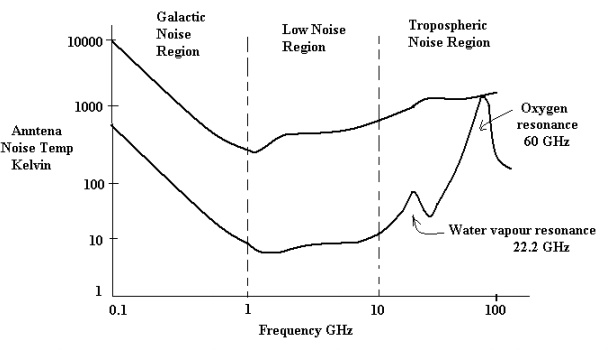
The upper
curve represents an antenna at low elevation (~ 5o above horizon),
the lower curve represents an antenna pointing at the zenith (i.e. 90o
elevation).
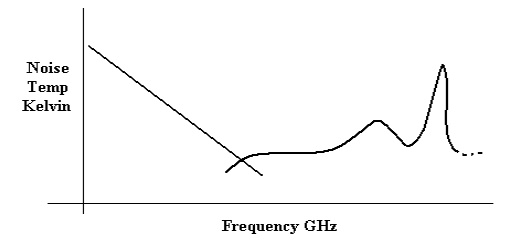
Contributions
to the above diagram are from galactic noise and atmospheric noise as shown
below.Note that sky noise is least over the band – 1 GHz to 10 GHz. This is
referred to as a low noise ‘window‘ or region and is the main reason why
satellite links operate at frequencies in this band (e.g. 4 GHz, 6GHz, 8GHz).
Since signals received from satellites are so small it is important to keep the
background noise to a minimum.
Naturally
occurring internal noise or circuit noise is due to active and passive
electronic devices (e.g. resistors, transistors ...etc) found in communication
systems. There are various mechanism which produce noise in devices; some of
which will be discussed in the following sections.
·
THERMAL
NOISE (JOHNSON NOISE):
This type
of noise is generated by all resistances (e.g. a resistor, semiconductor, the
resistance of a resonant circuit, i.e. the real part of the impedance, cable
etc).
Free
electrons are in contact random motion for any temperature above absolute zero
(0 degree K, ~ -273 degree C). As the temperature increases, the random motion
increases, hence thermal noise, and since moving electron constitute a current,
although there is no net current flow, the motion can be measured as a mean
square noise value across the resistance.
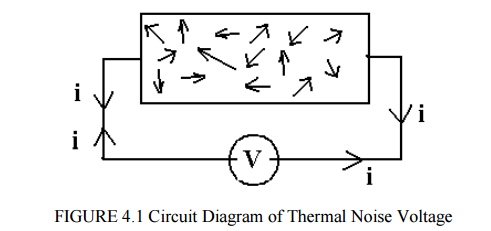
Experimental
results (by Johnson) and theoretical studies (by Nyquist) give the mean square
noise

Where k =
Boltzmann‘s constant = 1.38 x 10-23 Joules per K
T =
absolute temperature
B = bandwidth
noise measured in (Hz)
R =
resistance (ohms)
The law
relating noise power, N, to the temperature and bandwidth is
N = k TB
watts
These
equations will be discussed further in later section.
The
equations above held for frequencies up to > 1013 Hz (10,000 GHz)
and for at least all practical temperatures, i.e. for all practical
communication systems they may be assumed to be valid.Thermal noise is often
referred to as ‘white noise‘ because it has a uniform ‘spectral density‘.
Note –
noise power spectral density is the noise power measured in a 1 Hz bandwidth
i.e. watts per Hz. A uniform spectral density means that if we measured the
thermal noise in any 1 Hz bandwidth from ~ 0Hz → 1 MHz → 1GHz …….. 10,000 GHz etc we would measure the same
amount of noise.
From the
equation N=kTB, noise power spectral density is po = k T watts per Hz. I.e. Graphically
figure 4.2 is shown as,
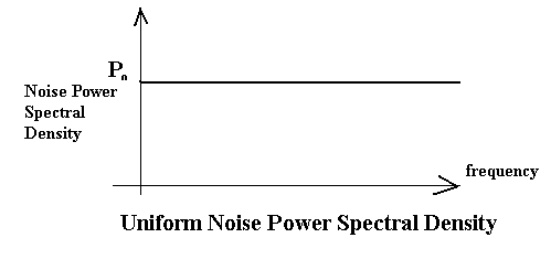
·
SHOT
NOISE:
Shot
noise was originally used to describe noise due to random fluctuations in
electron emission from cathodes in vacuum tubes (called shot noise by analogy
with lead shot). Shot noise also occurs in semiconductors due to the liberation
of charge carriers, which have discrete amount of charge, in to potential
barrier region such as occur in pn junctions. The discrete amounts of charge
give rise to a current which is effectively a series of current pulses.
For pn
junctions the mean square shot noise current is
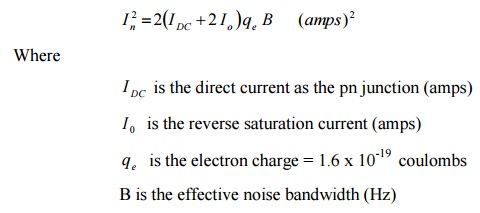
Shot
noise is found to have a uniform spectral density as for thermal noise.
·
LOW
FREQUENCY OR FLICKER NOISE:
Active
devices, integrated circuit, diodes, transistors etc also exhibits a low
frequency noise, which is frequency dependent (i.e. non uniform) known as
flicker noise or ‘one – over – f‘ noise.
The mean square value is found to be proportional to (1/f) where f is the frequency and n= 1.
Thus the
noise at higher frequencies is less than at lower frequencies. Flicker noise is
due to impurities in the material which in turn cause charge carrier
fluctuations.
·
EXCESS
RESISTOR NOISE:
Thermal
noise in resistors does not vary with frequency, as previously noted, by many
resistors also generates as additional frequency dependent noise referred to as
excess noise. This noise also exhibits a (1/f) characteristic, similar to
flicker noise.
Carbon
resistor generally generates most excess noise whereas were wound resistors
usually generates negligible amount of excess noise. However the inductance of
wire wound resistor limits their frequency and metal film resistor are usually
the best choices for high frequency communication circuit where low noise and
constant resistance are required.
·
BURST
NOISE OR POPCORN NOISE:
Some semiconductors also produce burst or popcorn noise with a spectral density which is proportional to (1/f)2
ü GENERAL COMMENTS:
The
diagram below illustrates the variation of noise with frequency.
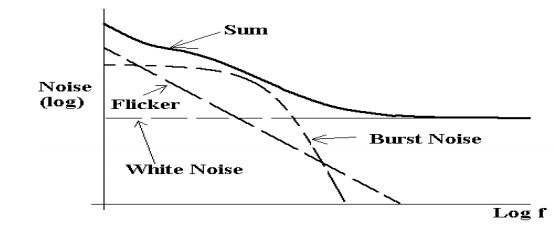
For
frequencies below a few KHz (low frequency systems), flicker and popcorn noise
are the most significant, but these may be ignored at higher frequencies where
‗white‘ noise predominates.
Thermal
noise is always presents in electronic systems. Shot noise is more or less
significant depending upon the specific devices used for example as FET with an
insulated gate avoids junction shot noise. As noted in the preceding
discussion, all transistors generate other types of
‗non-white‘
noise which may or may not be significant depending on the specific device and
application. Of all these types of noise source, white noise is generally
assumed to be the most significant and system analysis is based on the
assumption of thermal noise. This assumption is reasonably valid for radio
systems which operates at frequencies where non-white noise is greatly reduced
and which have low noise ‗front ends‘ which, as shall be discussed, contribute
most of the internal (circuit) noise in a receiver system. At radio frequencies
the sky noise contribution is significant and is also (usually) taken into
account.
Obviously,
analysis and calculations only gives an indication of system performance.
Measurements of the noise or signal-to-noise ratio in a system include all the
noise, from whatever source, present at the time of measurement and within the
constraints of the measurements or system bandwidth.
Before
discussing some of these aspects further an overview of noise evaluation as
applicable to communication systems will first be presented.
ü NOISE EVALUATION:
·
OVERVIEW:
It has
been stated that noise is an unwanted signal that accompanies a wanted signal,
and, as discussed, the most common form is random (non-deterministic) thermal
noise.
The
essence of calculations and measurements is to determine the signal power to
Noise power ratio, i.e. the (S/N) ratio or (S/N) expression in dB.
i.e. Let S= signal power (mW)
N = noise power (mW)
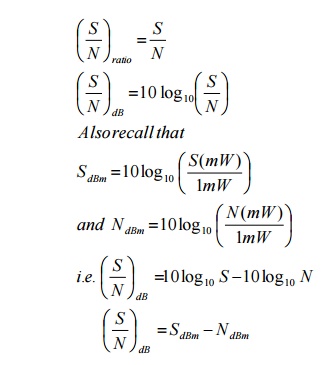
Noise,
which accompanies the signal is usually considered to be additive (in terms of
powers) and its often described as Additive White Gaussian Noise, AWGN, noise.
Noise and signals may also Powers are usually measured in dBm (or dBw) in communications systems. The equation (S/N)dB = SdBM - NdBm is often the most useul. The (S/N) at various stages in a communication system gives an indication of system quality and performance in terms of error rate in digital data communication systems and ‗fidelity‘ in case of analogue communication systems. (Obviously, the larger the (S/N) , the better the system will be).
AWGN.In
order to evaluate noise various mathematical models and techniques have to be
used, particularly concepts from statistics and probability theory, the major
starting point being that random noise is assumed to have a Gaussian or Normal
distribution.
We may
relate the concept of white noise with a Gaussian distribution as follows:

Gaussian
distribution – ‗graph‘ shows Probability of noise voltage vs voltage – i.e.
most probable noise voltage is 0 volts (zero mean). There is a small
probability of very large +ve or –ve noise voltages.
White
noise – uniform noise power from ‘DC‘ to very high frequencies.
Although
not strictly consistence, we may relate these two characteristics of thermal
noise as follows:
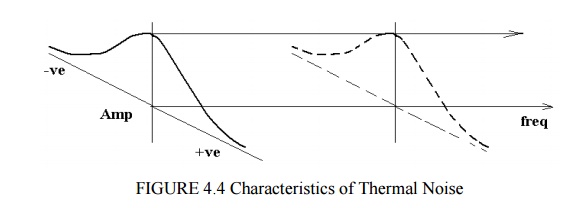
The
probability of amplitude of noise at any frequency or in any band of
frequencies (e.g. 1 Hz, 10Hz… 100 KHz .etc) is a Gaussian distribution.Noise
may be quantified in terms of noise power spectral density, p0 watts
per Hz, from which Noise power N may be expressed as
N= p0
Bn watts
Where Bn
is the equivalent noise bandwidth, the equation assumes p0 is constant across the band (i.e. White Noise).
Note - Bn
is not the 3dB bandwidth, it is the bandwidth which when multiplied by p0
Gives the
actual output noise power N. This is illustrated further below.
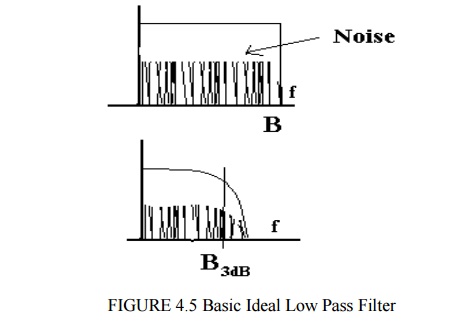
Ideal low
pass filter
Bandwidth
B Hz = Bn
N= p0
Bn watts
Practical
LPF
3 dB
bandwidth shown, but noise does not suddenly cease at B3dB
Therefore,
Bn > B3dB, Bn depends on actual filter.
N= p0
Bn
In
general the equivalent noise bandwidth is > B3dB.
Alternatively,
noise may be quantified in terms of ‘mean square noise‘ i.e. bar (V2)
, which is effectively a power. From this a ‗Root mean square (RMS)‘ value for
the noise voltage may be determined.

In order
to ease analysis, models based on the above quantities are used. For example,
if we imagine noise in a very narrow bandwidth, δf, as δf->df, the noise approaches a sine wave (with frequency
‘centred‘ in df).Since an RMS noise voltage can be determined, a ‗peak‘ value
of the noise may be invented since for a sine wave

Note –
the peak value is entirely fictious since in theory the noise with a Gaussian
distribution could have a peak value of + ¥ or - ¥ volts.
Hence we
may relate

Problems
arising from noise are manifested at the receiving end of a system and hence
most of the analysis relates to the receiver / demodulator with transmission
path loss and external noise sources (e.g. sky noise) if appropriate, taken
into account.
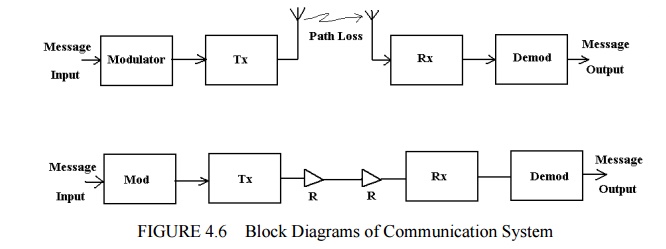
Transmission
Line
R =
repeater (Analogue) or Regenerators (digital)
These
systems may facilitate analogue or digital data transfer. The diagram below
characterizes these typical systems in terms of the main parameters.

PT represents the output power at the transmitter. transmitter.
GT represents the Tx aerial gain.
Path loss
represents the signal attenuation due to inverse square law and absorption e.g.
in atmosphere.
G
represents repeater gains.
PR
represents receiver inout signal power
NR
represents the received external noise (e.g. sky noise)
GR
represents the receiving aerial gain.

ü DATA ERROR RATE represents the quality
of the output (probability of error) for
digital
data system.
Related Topics